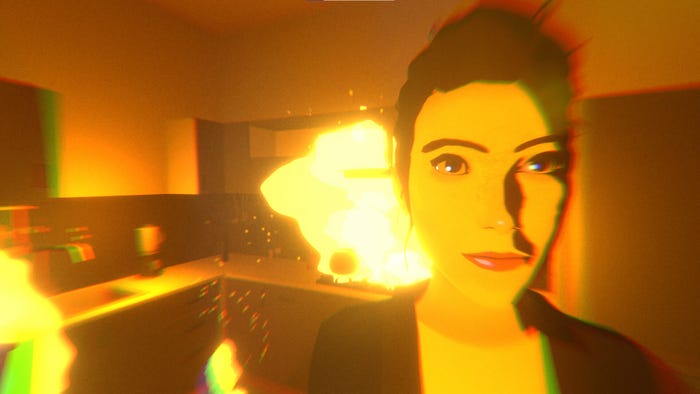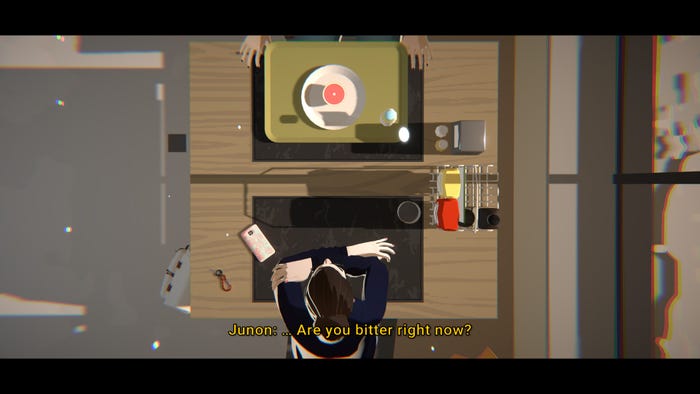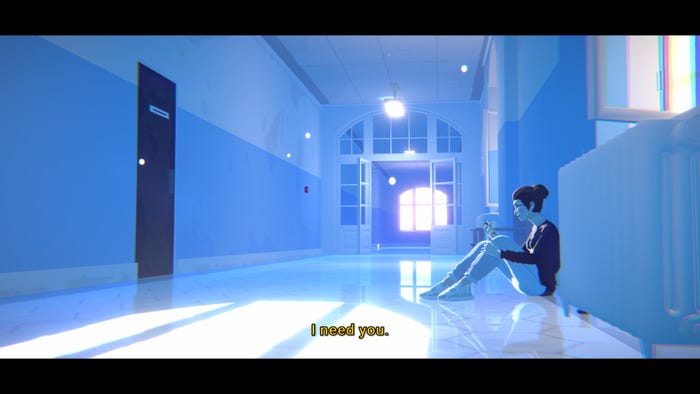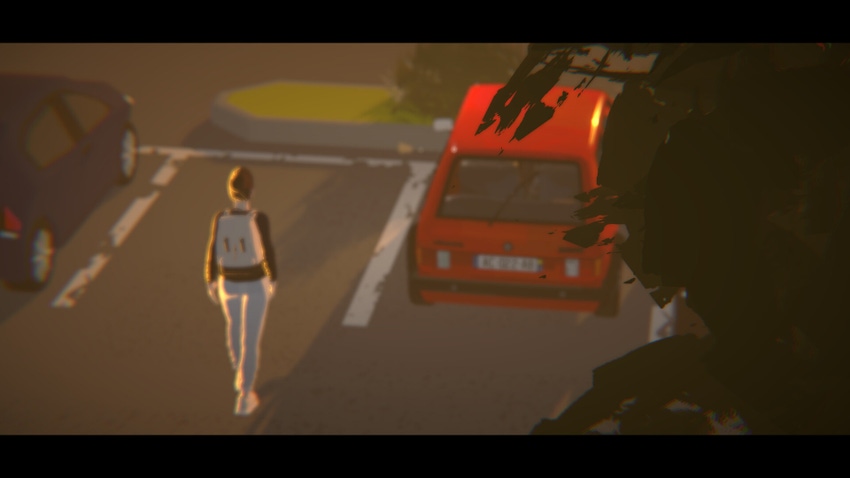The IGF (Independent Games Festival) aims to encourage innovation in game development and to recognize independent game developers advancing the medium. Every year, Game Developer sits down with the finalists for the IGF ahead of GDC to explore the themes, design decisions, and tools behind each entry. Game Developer and GDC are sibling organizations under Informa Tech.
The Wreck follows Junon as she navigates her mother’s imminent death, exploring memories through a horrifying car crash in the past that shapes and forms everything in the present.
Game Developer caught up with the game’s lead writer and designer, Florent Maurin, to talk about the real car accident that inspired the game’s core moment, exploring the messy and weird ways that real people respond to trauma and tragedy, and how creating this experience helped him explore his own personal thoughts, fears, and family connections.
Who are you, and what was your role in developing The Wreck?
My name is Florent Maurin. I'm 44 and I live in southern Burgundy, France. I was lead writer and game designer on The Wreck.
What's your background in making games?
After working as a journalist for 10 years, I founded The Pixel Hunt in 2014. Our studio specializes in what I like to describe as 'reality-inspired games,' which, while striving to be entertaining, are also designed to offer commentary on the world we live in.

Images via The Pixel Hunt
How did you come up with the concept for The Wreck?
One morning, as we were putting the final touches on our first commercial game, Bury me, my Love, I was in a car accident with my youngest daughter in the back of the car. Luckily, we got out of it okay (my daughter didn't even wake up from her nap!), but the experience was rather intense.
I actually experienced what I thought was but a movie trope: the crash seemed to happen in super slow motion and was interspersed with flashes from my life. I experienced memories from my childhood, weird out-of-place thoughts ("Should I prune my cherry tree?") and millions of other signs of a frantic neuronal activity—maybe related to my brain trying to find a useful memory to help get me out of this perilous situation. A few moments later, as I was picking up broken car parts from the road, I already knew I wanted to turn this experience into a game.
What development tools were used to build your game?
We used Unity as a game engine, Blender for 3D assets production, Fmod for dynamic sound management, and Ink to manage all things story-related. A big shout-out to Inkle, by the way: it's amazing of them to have made their narrative engine open source.
The Wreck centers on a devastating question about a dying (and hated) parent. What thoughts went into making this challenging choice into a major part of the game?
My sister Coralie (who co-wrote the game with me) and I lost our father at a young age. Even though we were never faced with such a dilemma Junon has to deal with in the game, we still accompanied his last moments, and that life experience made us grow and bond. I guess my desire to talk about that—how do you face the death of people that are important to you—comes from that personal experience, and the good that came out of it through the pain.
That being said, Junon has a way more difficult relationship with her mother than we had with our dad. I guess that came to be because we wanted to reflect on whether love and hope can prevail even in dysfunctional families—and how.
The game tackles many complex questions and thoughts with a human messiness and complexity. What challenges come from facing these kinds of ideas head-on in writing?
We adopted a character-based approach: we had our cast of characters and interpersonal dynamics before we even knew what was going to happen in the story. Then, we let them surprise us, putting them in specific situations and "letting" them lead in the most spontaneous, messy, weird, human ways possible.
More often than not, when people write, they use their characters to advance the plot. That makes for stories that are often well-oiled and relentless, but that also can feel mechanical, as everything happens for a reason. On the contrary, we decided to let things happen, then see how to wrap them together (if it was possible at all). I think that can give birth to stories that feel way less controlled, but also way more believable, and it seemed like a better fit for the kind of narrative we wanted for The Wreck.

Images via The Pixel Hunt
How do you tackle all of the weird, dark, wild, and unexpected ways in which people face the most difficult moment of their lives in believable ways?
My personal take on this is, there is no "right" way to react to the shit life throws at you. When I worked on Bury me, my Love, I read a lot of stories by refugees who fled from Syria and found refuge in Europe—which is what the game is about. Among those, I was struck by the experience of a couple that made it by flying to... Brazil, and then back to Germany, through a very bizarre sequence of events. That's when I realized that, if you want to write a compelling story about a real-life event (especially a dark one), you have to be as messy, weird, and uncontrollable as life can be.
Take grief, for instance. Through a lot of works of fiction, we have a preconceived idea of what it is—the Kübler-Ross 5 stages model, the crying, the devastation... But in reality, the experience is way more complex and weird than that. I understand the need to resort to tropes in hopes to establish a connection with a wide audience, but I believe people can actually connect way more intensely with a character that seems weird as long as there's an underlying coherence —a method to that madness.
You mentioned in a previous interview that you really try to get into a character's mindset when you're writing about them. Can you tell us about how you get yourself into this mindset? How do you get yourself to see the world through someone else's eyes?
It's a tough one! I don't want to perpetuate the myth that pretends that a writer lives, eats and breathes with their characters because I think romanticizing our activity too much does more harm than good. But it's true that, after a little while, you tend to consider every life situation, even the most trivial, through your main character's eyes.
For instance, I remember quite vividly dropping a mug full of coffee, one morning. That made a heck of a mess, but my first reflex, instead of screaming in rage or crying in agony like any normal people, was to ask myself: "How would Junon react to such a blatant display of clumsiness?" I'm not sure how exactly I got into that mindset, but it's pretty useful because, day after day, it provides you with an ever-more-intimate knowledge of your hero, and that's a tremendous help when you then throw them in weird situation. It's basically a useless skill to clean up the kitchen, though.
The main character, Junon, is also dealing with her own challenges in her life and the aftermath of a car crash in The Wreck. You had mentioned in that same interview with Game Developer that this game was developed based on your own experiences in a car crash. Did working on this game help you with your emotions around that moment in any way?
It did. And sorry, but this answer will contain a spoiler for the game's plot. I think the most striking part of the car crash experience wasn't the crash itself, but the sudden realization of how fast your life can be completely transformed. I could have died in that accident, or worse, something could have happened to my daughter. I am a fairly anxious person, and since I became a father, the idea that something could happen to my daughter has been haunting me. I think all parents have had to deal with such thoughts at some point.
So for me, working on The Wreck was a way to explore that fear—to confront it instead of brushing it under the rug—and to relieve myself from some of the distress it provoked. I hope that, by doing so, I've also been able to come up with a story that may provide some sort of catharsis to other parents out there.
What effects did creating art around such a moment in your life affect you, in good ways and bad?
One of the best things about working on The Wreck was that it helped me realize how close my sister Coralie and I are. More often than not, I would pitch her ideas for characters, dynamics, and scenes, and after a few words, she would completely get what I was aiming at. This was nothing magical (even though Coralie's a very gifted writer). It was just that our common life experiences, that we had never discussed openly before, provided us with a deep understanding of each other's mindset. We have very different lives, but the bond that we have really shone through our common creative process.
As for the bad ways in which it affected me, I don't thing there are, to be honest (except maybe that, because we had a lot to do and not many resources, it was a rather draining experience). And also, when you make something that's this personal, you're even more affected by negative criticism. Don't get me wrong, the public reception for the game has been stellar, but you know that meme that shows an artist only noticing a single negative social media post in a sea of positive ones? Well, that was me for a long time after we released the game.

Images via The Pixel Hunt
Much of the game is spent piecing together memories on the worst day of its main character's life. What thoughts went into creating the ways in which players can explore and find hidden elements of those memories?
The process has been rather variable depending on the memory. Some were clearly identified narrative devices that we absolutely needed to push the story forward. But for others, it started with a visual idea that our art director, Alexandre Grilletta (Alex), had. For instance, the Russian doll style dollhouse memory initially is something he thought would be pretty cool to experience, so he asked whether we saw room for a dollhouse in the story.
I found that way of doing things pretty cool, because having to make way for someone else's ideas is also a great way to come up with twists and turns that you would not necessarily imagine yourself. Of course, Alex's suggestions weren't coming out of nowhere because we were constantly pitching him the material we had. But I think this back-and-forth, iterative process made for a pretty original experience in the end.
What interested you in exploring story through examining and re-examining memories? About retreading these memories with new thoughts and ideas that recontextualize them?
It's kind of how I process the things that happen to me in real life, to be honest. More often than not, I happen to vividly remember scenes from the past without knowing why those specific moments stick, until at some point I experience a kind of tiny rapture. I make connections which weren't there the day before, or which I wasn't yet ready to bring to my own consciousness, if that makes sense. And suddenly, my whole reading of the situation is changed.
I think that's the most concrete example of what it actually feels like to experience growing up, and as we wanted The Wreck to be a story about growth, we figured it'd make sense to translate that feeling into a game mechanic.
The Wreck plays around with size, shape, and surreal visuals throughout its exploration of the past and memories. What ideas went into its visual style? Into the look of delving into the past?
Alex spent a lot of time thinking about that. The challenge was to convey a feeling that would be clearly different between the real world (what we call the "last day") and the memories, but he also really wanted to avoid the tropes usually activated to invoke the past—sepia tones, visual artifacts, items floating in some kind of foggy mist... Instead, he went with a more dreamlike style and experimented with slightly surreal concepts: impossible geometries, surprising match cuts, time lapses...
In The Wreck, each memory is different, but they all share a vivid, cinematic appearance. That also has to do with Junon being a screenwriter. We thought it might make sense for her memories to feel like cool movie shots.
Likewise, what ideas specifically went into the design of the car crash memory? Can you tell us about how you crafted this vital moment in the game?
This was a lot of work by our animator, Peggy Lecouvey. Alex and I watched a bunch of dashcam videos of crashes and spent quite a long time crashing cars in BeamNG Drive in order to block out a first version of the scene that worked. Then Peggy took over, and she's the one who came up with the final version.
The challenge was to have a scene that would both feel real, and even painful, when played at normal speed, but that would convey an eerie, surreal feeling when experienced in slo-mo, with items floating around the main character working as gameplay elements, as they are doors to Junon's memories. This took quite a lot of iterations, and we're really happy with the end result.




